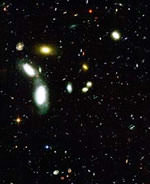
Image credit: Hubble
A new series of images taken by the Hubble Space Telescope contain 25,000 galaxies, many of which are interacting and in the process of formation. Some of these galaxies are so far away, they’re seen when the Universe was only 2 billion years old. Astronomers are using Hubble and the Chandra X-Ray observatory to survey two large areas of the sky to build a deeper understanding of galaxy evolution.
NASA’s Hubble Space Telescope reached back to nearly the beginning of time to sample thousands of infant galaxies. This image, taken with Hubble’s Advanced Camera for Surveys, shows several thousand galaxies, many of which appear to be interacting or in the process of forming. Some of these galaxies existed when the cosmos was less than about 2 billion years old. The foreground galaxies, however, are much closer to Earth. Two of them [the white, elongated galaxies, left of center] appear to be colliding.
This image represents less than one-tenth of the entire field surveyed by Hubble. The full field, consisting of about 25,000 galaxies, is part of a larger survey called the Great Observatories Origins Deep Survey (GOODS), the most ambitious study of the early universe yet undertaken with the Hubble telescope. This survey targeted two representative spots in the sky – one in the Northern Hemisphere and the other in the Southern Hemisphere. This image represents the southern field, located in the constellation Fornax. The entire GOODS survey reveals roughly 50,000 galaxies. Astronomers have identified more than 2,000 of them as infant galaxies, observed when the universe was less than about 2 billion years old.
Because infant galaxies are very faint and very rare, astronomers are using Hubble to search for them over a relatively wide swath of sky. In fact, the new observations cover about 60 times the area of the original Hubble Deep Field Observations, obtained in 1995. Astronomers also are using the Chandra X-ray Observatory to search the GOODS fields for the earliest black holes in the universe. The Space Infrared Telescope Facility (SIRTF) will sample these same fields soon after it is launched in August 2003.
By combining light from all three of NASA’s great observatories with data from ground-based telescopes, astronomers hope to build a coherent picture of galaxy evolution.
This image of the southern field was assembled from observations taken between July 2002 and February 2003.
Original Source: Hubble News Release
